In 2024, finding the best office chair cushion for hip pain or the best seat cushion for hip bursitis is not a mere comfort choice; it’s a necessity. Daily discomfort while working can seriously hamper productivity. In this guide, we’ll help you navigate through the multitude of options and discover the optimal solution to alleviate your hip pain while sitting. Say goodbye to those aches and discomfort as we unveil the top contenders in the cushion market, ensuring your workday remains pain-free and efficient.
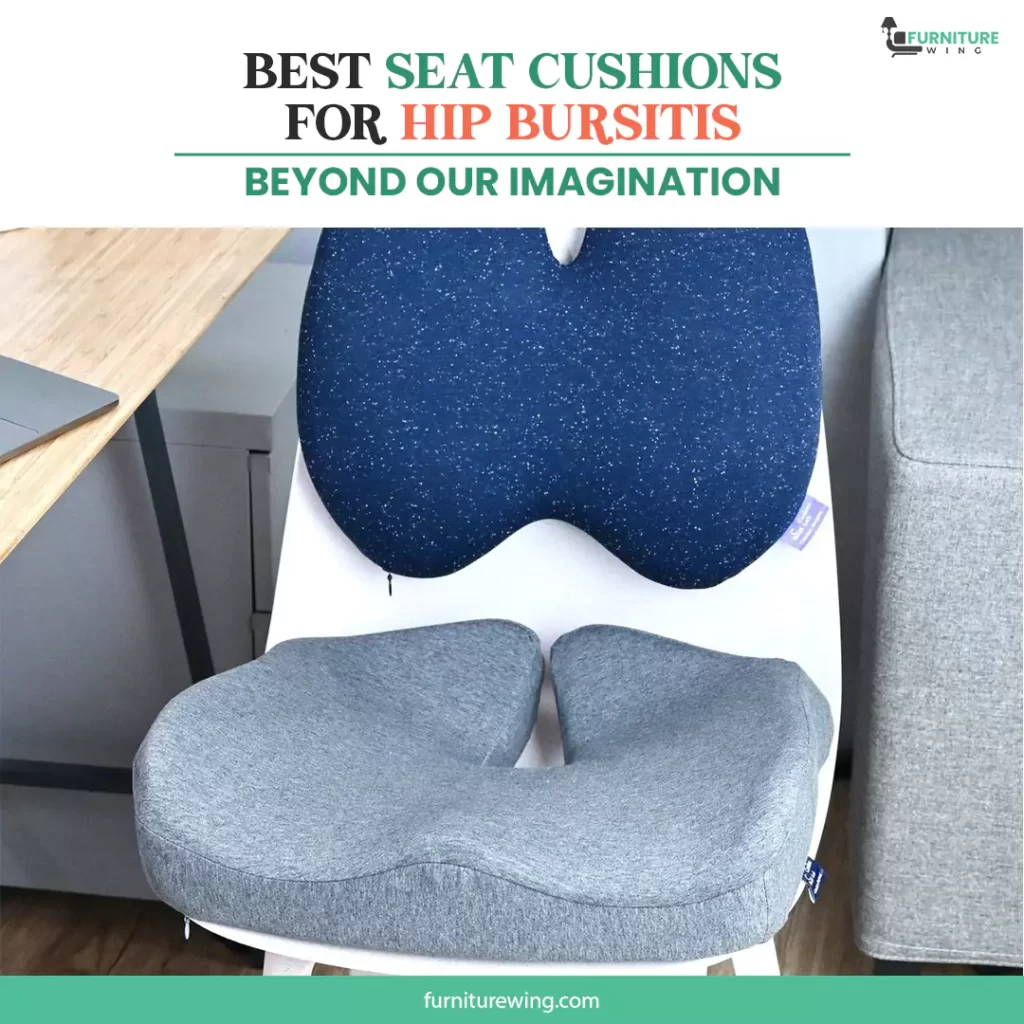
The Best Seat Cushion for Hip Bursitis: Finding Comfort and Relief
Hip bursitis is a disorder that can make moving around and living in general painful and uncomfortable since it affects the hip joint. The management of hip bursitis symptoms and the provision of much-needed relief and comfort can be greatly improved by selecting the proper seat cushion. In this extensive tutorial, we will examine the origins and signs of hip bursitis, comprehend how it affects day-to-day activities, and delve into the elements to take into account while picking the ideal seat cushion. Investigate the top hip bursitis seat cushions, which provide instruction, maintenance, and evaluation for educated decision-making and improved hip health.
Main Causes and Symptoms of Hip Bursitis
The bursae, which are sacs that cushion the tendons, ligaments, and muscles, enlarge painfully when they get bursitis. Bursitis is a painful swelling of the bursae, which are sacs that cushion the tendons, ligaments, and muscles. Trochanteric bursitis is an inflammation of the hip bursae that causes uncomfortable and painful areas.
Causes Of Hip Bursitis
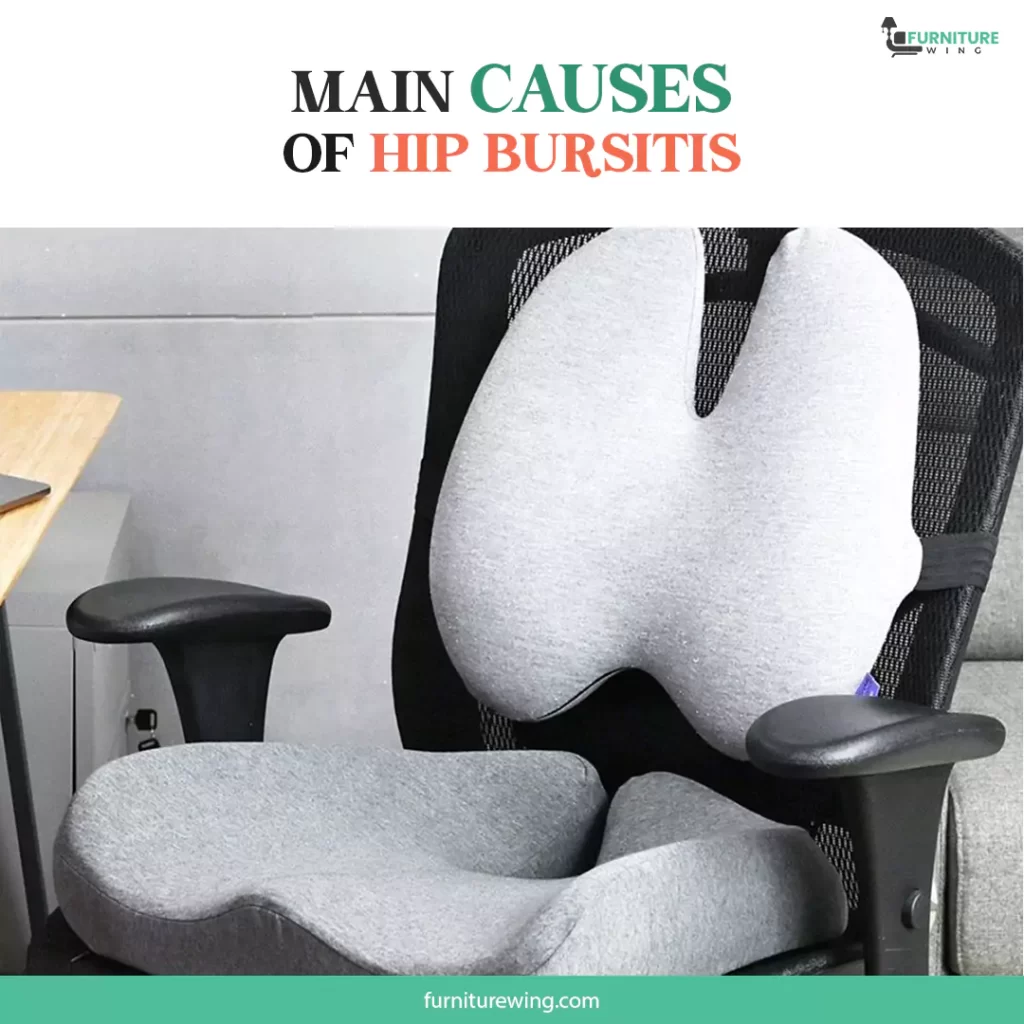
- A recurring injury: Repetitive stress and overuse injuries that put pressure on the bursa as a result of repetitive use can lead to hip bursitis. Running, stair climbing, cycling, and extended periods of standing put stress on the hip joint and its supporting tissues.
- Hip Injury(Traumatic Injuries): Traumatic hip bursitis occurs when the bursa lining becomes inflamed from falling or banging on a hard surface, causing symptoms. Although blood may be reabsorbed, the lining remains inflamed.
- Overweight: Being overweight can cause hip bursitis by straining the hip joint, altering gait biomechanics, or both, increasing the risk of the condition.
- Inflammation History (friction or persistent pressure): Inflammatory disorders like psoriasis, thyroid illness, gout, and rheumatoid arthritis increase the risk of hip bursitis developing later on. Repetitive mini-traumas to the bursa can be the reason, and activities like riding, running, or climbing stairs might make it worse.
- Medical complications (Past hip surgery): Hip bursitis can develop after hip surgery, including hip replacement, especially during the acute healing stage. Gout and rheumatoid arthritis can cause chronic issues.
- Inferior biomechanics: Improper biomechanics, which include posture, walking style, scoliosis, and lumbar spine arthritis, bring hip bursitis. These physical issues can also result from spinal abnormalities. Leg length inequality can potentially have an impact on hip biomechanics and inflammation.
- Inequality of leg length: When one leg is much shorter than the other, it alters your walking style and might cause hip bursa irritation.
Hip bursitis signs and symptoms
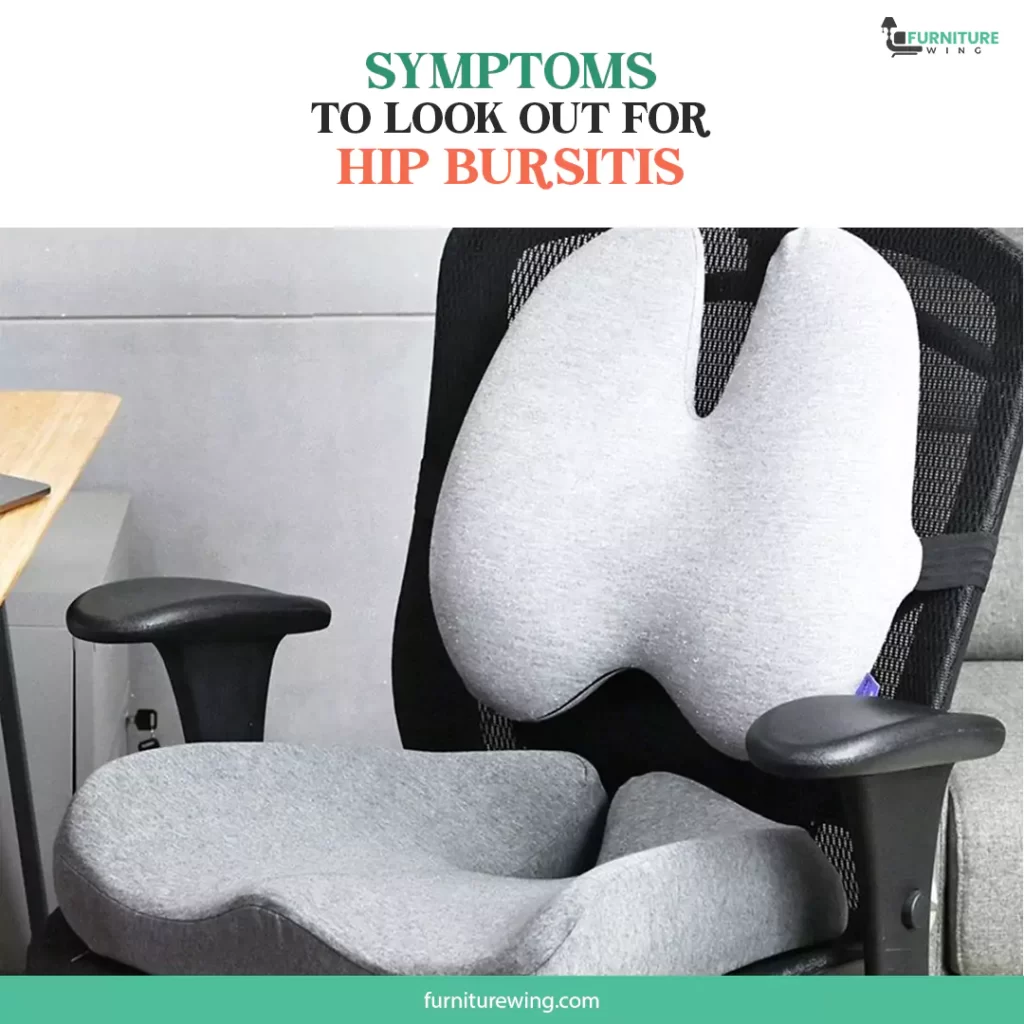
- Bursitis frequently causes joint pain, trouble moving, tenderness, swelling, loss of movement, fever, and joint redness.
- It might last a few days to several weeks and flare up over hours or days.
- Acute bursitis might become chronic if it returns or if a hip injury develops.
- Symptoms include joint discomfort, soreness, swelling, and warmth.
- The pain is intense in the first few days and is worse at night when lying on the affected hip and when getting up from a chair.
- Bursae can develop with time, causing swelling and restricted movement.
Hip Bursitis Diagnosis
- MRIs, aspiration, and blood tests are a few of the diagnostic techniques utilized to determine bursitis.
- Using imaging procedures like X-rays, MRIs, ultrasounds, or bone scans, doctors evaluate patients’ pain, mobility, strength, and underlying disorders.
- Bursae that are too deep for routine inspection are treated with MRIs and ultrasounds.
- Fluid withdrawal may be necessary to screen for infection in cases with excruciating edema.
The Impact of Hip Bursitis on Daily Life
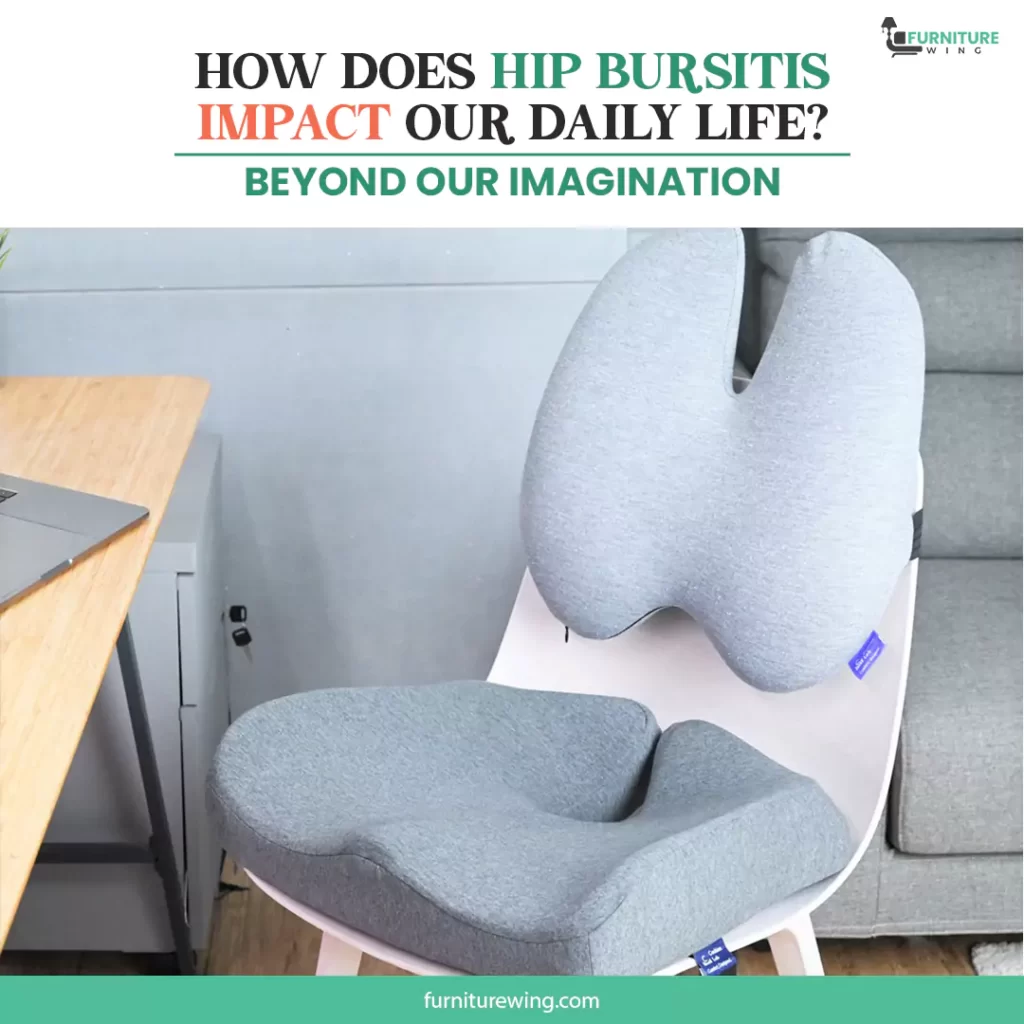
Hip bursitis substantially negatively influences daily life, making tasks difficult and uncomfortable, reducing productivity, and impairing mobility. The lower back and thigh may also experience pain, which can restrict motion and be uncomfortable. Effective treatments, such as physical therapy exercises, can assist people with hip bursitis in managing their symptoms and lessen the burden of their impairment.
Benefits of Using the Best Office Chair Cushion for Hip Pain
For those suffering from hip bursitis, using an office chair cushion can significantly improve both comfort and overall well-being during work hours. Here are some notable benefits of the best office chair cushion for hip pain:
- Pressure Relief: A high-quality office chair cushion is designed to distribute body weight evenly, reducing pressure on the hips. This helps alleviate pain and discomfort caused by hip bursitis.
- Postural Support: Ergonomically designed office chair cushions provide proper support for the lower back, promoting a healthy posture. By maintaining correct alignment, these cushions can help prevent further aggravation of hip bursitis symptoms.
- Enhanced Comfort: Office chair cushions often feature memory foam or gel-infused materials that conform to the body’s contours. This contouring effect enhances comfort and reduces pressure on sensitive areas, such as the hips.
How to Find the Best Seat Cushion for Hip Bursitis?
Choosing the Best seat cushion for hip bursitis requires careful consideration of your unique requirements and preferences.
- Seek advice from a medical expert: For recommendations that are tailored to your needs and situation, speak with a healthcare professional such as an orthopedic surgeon or physical therapist.
- Read customer reviews: Look for seat cushions that have positive reviews from individuals with hip bursitis. Pay attention to feedback regarding comfort, pain relief, and durability.
- Experiment with various options: If feasible, test out different seat cushions before making a purchase. This will enable you to evaluate their comfort, support, and fit for your unique requirements. Some stores or online vendors may have trial periods or return policies, allowing you to test the cushion and ensure it matches your expectations.
- Consider additional features: Consider seat cushions with non-slip bottoms, washable covers, and built-in heating or cooling elements for added comfort and temperature regulation.
- Compare prices and warranties: Take the time to compare prices from different brands and retailers. Additionally, check if the seat cushion comes with a warranty or guarantee, as
What to Consider When Choosing the best seat cushion for hip bursitis?
When selecting a seat cushion for hip bursitis, several factors should be taken into account. These include:
- Material: Look for seat cushions that are both comfortable and durable, produced from high-quality materials. Popular options include orthopedic, memory, and gel-infused foams because they provide good support and contour to the body.
- Density: It is crucial, as not all foam or gel cushions are created equal.
- Bonus features, body type, and chair: Look for bonus features. Consider your body type and chair.
- Durability: Monitor wearing patterns, durability, patient reviews, and outputs of cushions you recommend.
- Design and shape: Opt for a seat cushion that has an ergonomic design, with contours that align with the body’s natural curves. This design helps reduce pressure points and provides optimal support to the hip region.
- Size and thickness: consider the size and thickness to ensure an optimal fit. Thickness determines the cushion’s suitability.
- Breathability: Breathability is important when choosing a seat cushion since it can help to reduce sweat and discomfort from prolonged sitting by promoting airflow and preventing heat buildup.
- Portability: Consider the cushion’s portability if you want to use it somewhere else. A portable, lightweight design will make it simpler to utilize wherever you need it.
- Scientific Properties: Discover how cushion manufacturers utilize scientific properties in material design and selection.
Tips for Proper Usage and Longevity of Seat Cushions
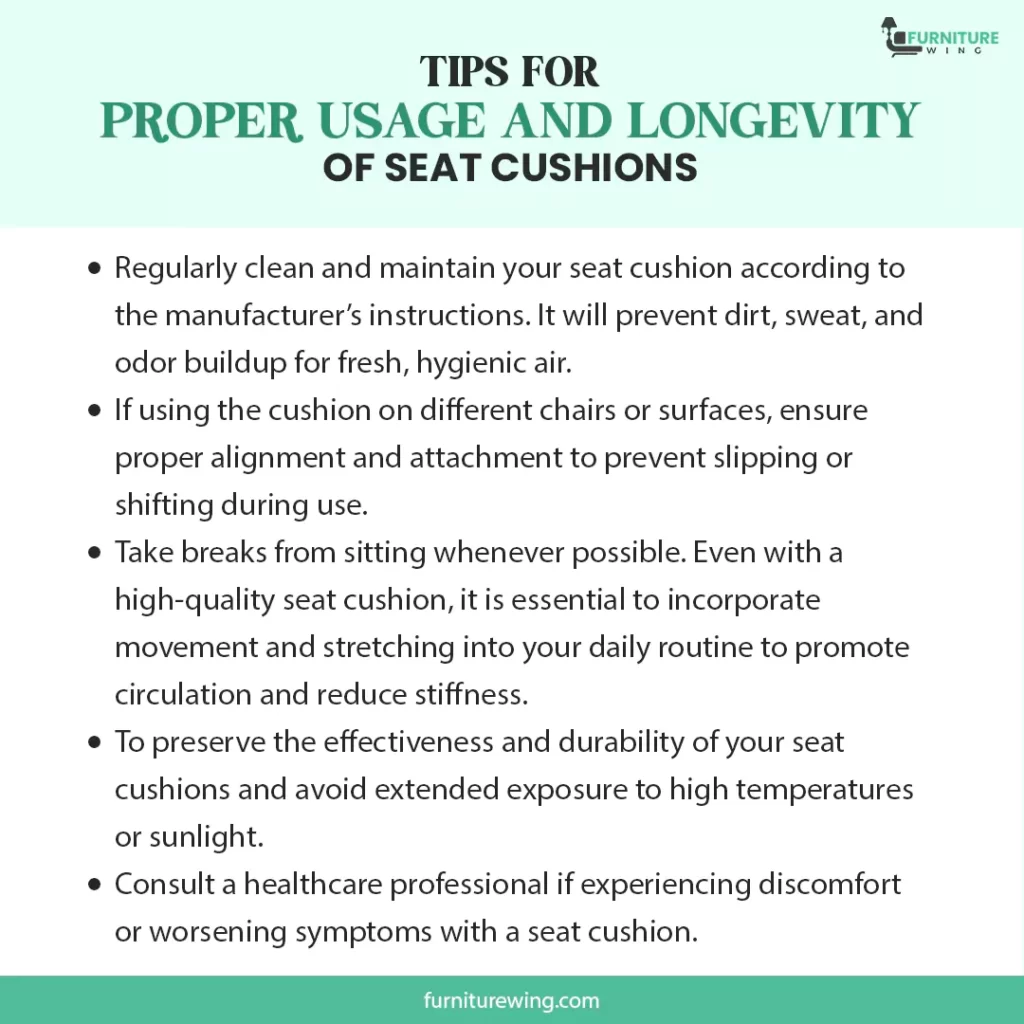
To ensure the longevity and effectiveness of your chosen seat cushion, consider the following tips:
- Regularly clean and maintain your seat cushion according to the manufacturer’s instructions. It will prevent dirt, sweat, and odor buildup for fresh, hygienic air.
- If using the cushion on different chairs or surfaces, ensure proper alignment and attachment to prevent slipping or shifting during use.
- Take breaks from sitting whenever possible. Even with a high-quality seat cushion, it is essential to incorporate movement and stretching into your daily routine to promote circulation and reduce stiffness.
- To preserve the effectiveness and durability of your seat cushions and avoid extended exposure to high temperatures or sunlight.
- Consult a healthcare professional if experiencing discomfort or worsening symptoms with a seat cushion.
Why Finding best seat cushion for hip bursitis Matters?

Finding the perfect seat cushion is essential for treating hip bursitis because it promotes good posture, eliminates poor habits, and enhances comfort.
- Relief from pressure: A well-designed seat cushion can uniformly distribute body weight, relieving strain on irritated bursae and fostering improved blood circulation.
- Postural support: Hip bursitis management requires proper alignment. An ergonomic seat cushion can assist in preserving good posture, easing strain, and supporting the spine’s natural curvature.
- Comfort and pain relief: A high-quality seat cushion helps ease discomfort and lessen pain related to hip bursitis by providing cushioning and support.
- Versatility: The greatest seat cushions for hip bursitis frequently have this quality and may be used in a variety of seating situations, including office chairs, automobiles, wheelchairs, and even airplanes. Because of its adaptability, relief is available wherever you are.
- For optimum support and pressure relief, a cushion must be solid, firm, and equipped with cooling capabilities.
How to Take Care of Your Hip Health Beyond Seat Cushions
- Exercise regularly (Stretching and strengthening exercises): Regular exercises like hip squeeze, leg raise, side leg raise, and hip rotation stretch strengthen hips and improve flexibility, stability, and joint health while targeting the hip and surrounding muscles.
- Maintain a healthy weight: Maintaining a healthy weight through proper nutrition and exercise can reduce strain on hip joints and alleviate extra pressure on the joints. Being overweight can also contribute to hip strain.
- Practice good posture: Maintain appropriate posture throughout the day, whether sitting, standing, or walking, to relieve hip joint pain and prevent excessive pressure on the hips.
- Avoid activities that aggravate symptoms: Identify activities that worsen hip bursitis symptoms and modify them whenever possible. Avoid high-impact exercises and prolonged sitting in uncomfortable positions. Sit for a long period to avoid pressure on the hips. Take breaks and walk every 30 minutes if sitting for extended periods.
- Utilize aids: If you have trouble standing or walking, using aids like a cane or walker can help relieve strain on your hips.
A Few Top Recommended Best Seat Cushions for Hip Pain
The most well-liked options in the market are:
- Memory Foam Seat Cushions: Memory foam seat cushions provide the best support and pressure relief because they mold to the curve of the body. They disperse weight evenly, lessening hip stress and easing hip bursitis pain. For the best hip support, choose contoured styles.
- Gel Seat Cushions: Gel seat cushions offer excellent support and cushioning, making them ideal for those with hip bursitis. The gel material molds to the body, reducing pressure points and providing relief to the affected area. Gel cushions also promote proper spinal alignment, which can further alleviate hip pain.
- Coccyx Seat Cushions: By relieving strain on the coccyx, coccyx seat cushions treat hip bursitis and reduce pressure on the tailbone. They indirectly relieve pressure on the hips. For increased comfort, select cushions with memory foam or gel inserts.
- Wedge Seat Cushions: They help to maintain good posture and a straight spine by tilting the pelvis forward, relieving hip pain, and distributing weight evenly. The pain from prolonged sitting is reduced, which is especially helpful for people with hip bursitis.
- Inflatable Seat Cushions: Individuals with varied pain levels can find individualized support, varying degrees of hardness, and focused comfort with these adjustable hip bursitis cushions.
Top 3 best seat cushion for hip bursitis
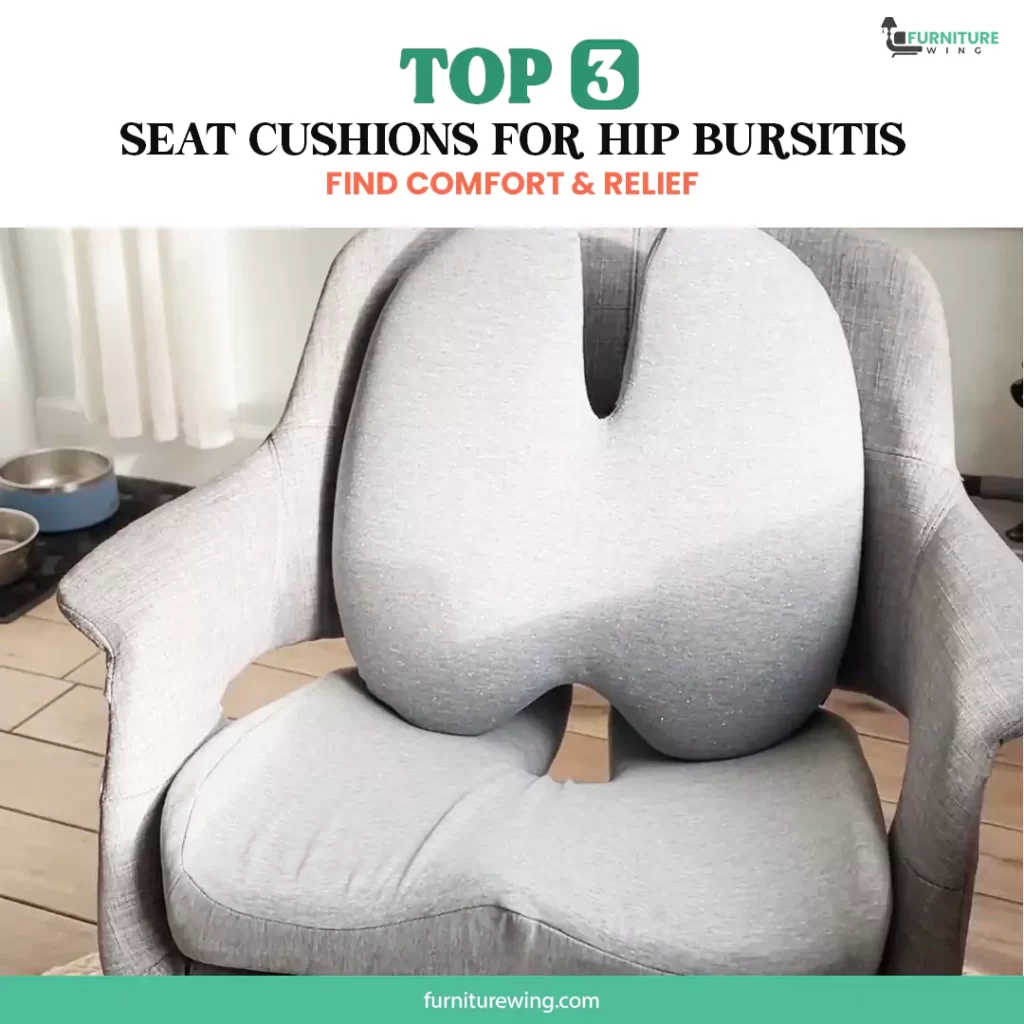
Cushion Lab Patented Pressure Relief Seat Cushion for Long Sitting Hours on Office/Home Chairs, Car, Wheelchair – Extra-Dense Memory Foam for Hip, Tailbone, Coccyx, Sciatica – Light Grey:
- Cushion Lab’s Pressure Relief Seat Cushion is a great solution for long-hour sitting, improving work and health. It not only makes your chair more comfortable but also offers a pain-free, enjoyable sitting experience. As the author is using it, they are satisfied with the results.
Steelcase Amia Ergonomic Office Chair with Adjustable Back Tension and Arms | Flexible Lumbar with Sliding Seat | Black Frame and Buzz2 Black Fabric:
- It is the best office chair cushion for hip pain. The Back has a flexible seat edge, continuously supports your lower back, molds to your body, and does so. With a weight capacity of 300 lbs. and a 10-year Steelcase warranty, it has four adjustable arms for posture support.
ComfiLife Gel Enhanced Seat Cushion – Non-Slip Orthopedic Gel & Memory Foam Coccyx Cushion for Tailbone Pain – Office Chair Car Seat Cushion – Sciatica & Back Pain Relief (Black):
- The gel cushion reduces force from road bumps, transferring it to the Back of the thighs. It is stronger and maintains its integrity, providing relief on the perineum. It is adjustable and suitable for various settings, including office chairs, cars, and churches, and is highly recommended for those with sciatica or other conditions.
Conclusion
In conclusion, the best office chair cushion for hip pain and the best seat cushion for hip bursitis can be the game-changer you need in your workspace. Investing in the right cushion is a direct investment in your well-being and productivity. With our guide, you can make an informed decision to keep hip pain at bay. So, select the ideal cushion and experience the comfort, relief, and focus you deserve in 2023. Your hip will thank you for it.
Post Author

John L. Negron,
I am John L. Negron, the co-editor of Furniturewing, and I bring to you my extensive experience as a professional interior designer and a dedicated research writer. I have curated a team of experts, each possessing specialized knowledge in various chair types.
Frequently Asked Questions
Is Seat Cushion Effective for Hip Pain?
Yes. Seat cushions can relieve back, neck, shoulder, coccyx, and hip pain, providing lumbar support, pain reduction, and spinal alignment when resting on the stomach.
Are seat cushions healthy?
Seat cushions collect posture and evenly distribute weight to improve chair comfort and lessen pain. The Back, joints, and spine can be strained by hard or poorly made chairs, which will exacerbate any existing back discomfort. Even if you’re in good health, using pillows will help you avoid pain in the future. Cushions can ease existing pain.
How can I find a seat cushion that would help my hip pain?
Because an orthopedic seat cushion may evenly distribute body weight throughout the bottom part of the body, orthopedics advises using one to relieve hip pain. For this reason, orthopedists advise utilizing a Pressure Relief Seat Cushion.
How much time should I spend using a seat cushion to treat hip bursitis?
In order to reduce strain on the hips, a seat cushion is advised for hip bursitis. Keep your legs straight and avoid spending a lot of time standing or sitting on soft surfaces. When sensations worsen during certain activities, use the cushion. For the proper duration, get advice from a medical practitioner.
Which cushion is best for relieving hip discomfort while seated?
A helpful aid for easing hip pain while sitting is a posture wedge cushion. It opens the front of the hips and releases tension on the side of the hips by raising the hips higher than the knees. For many persons who experience hip pain while sitting, this technique is quite useful.


Leave a Reply